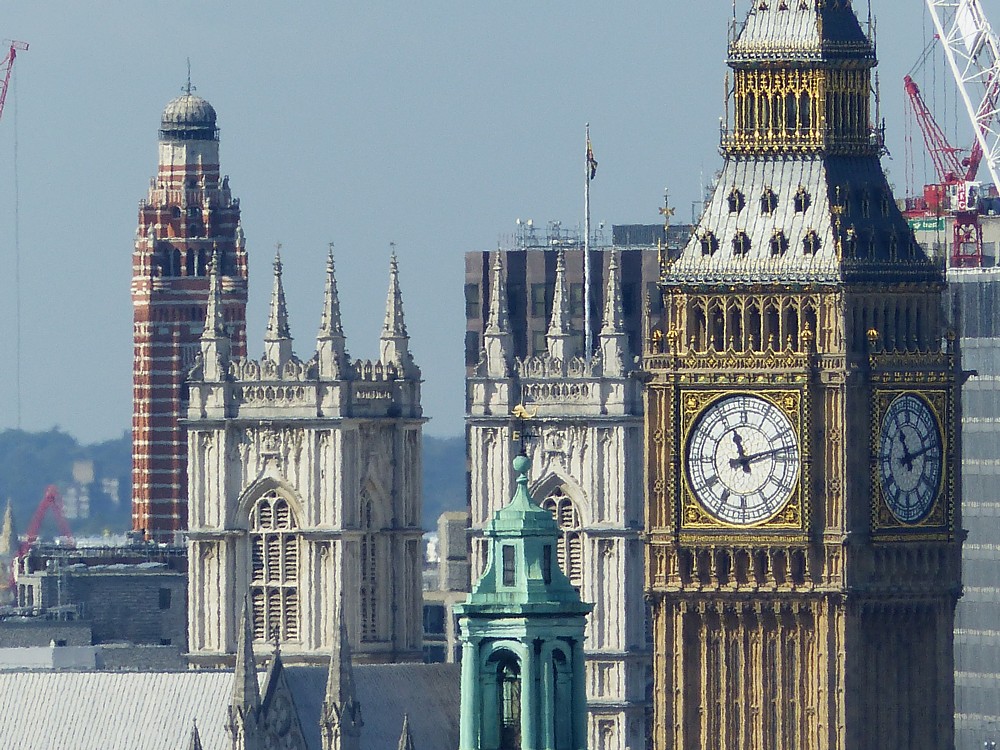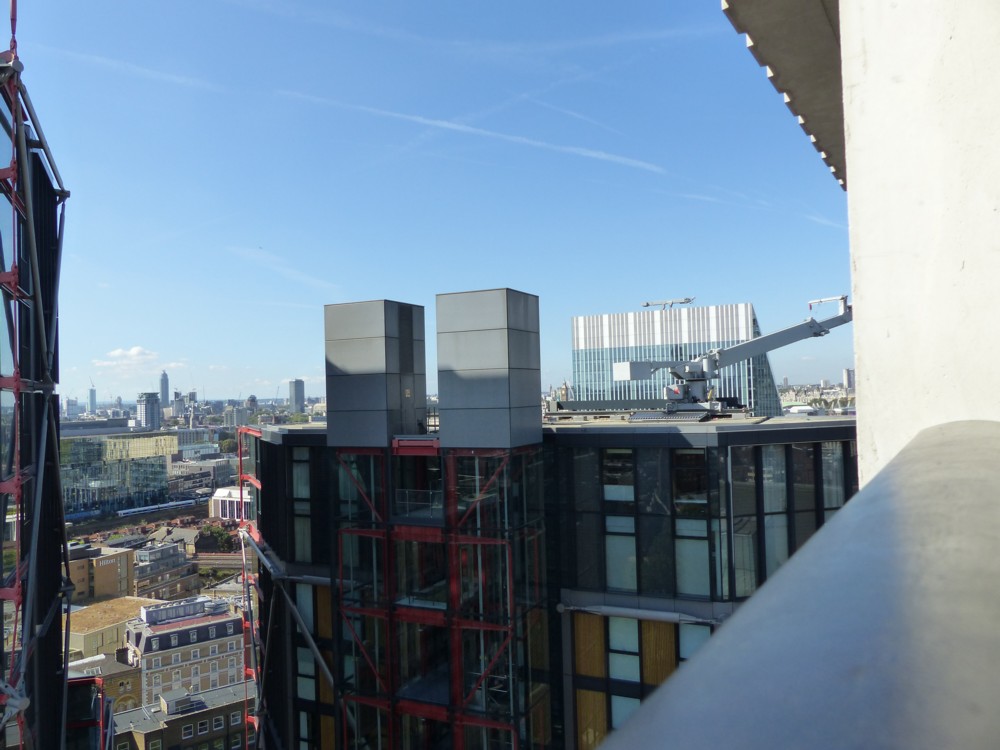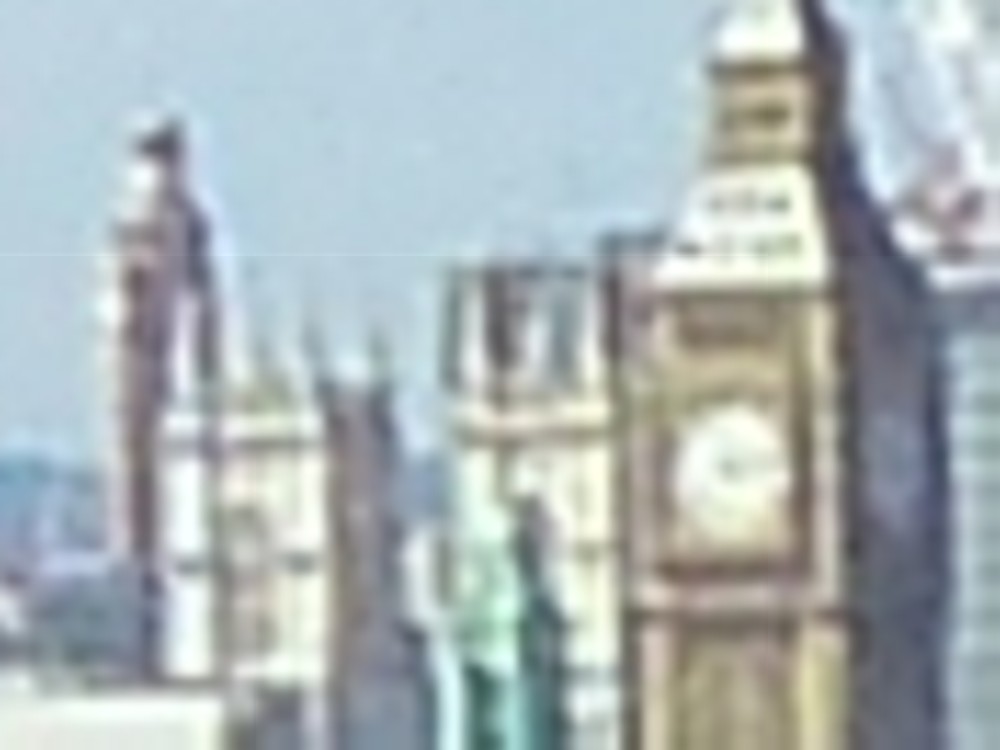In a recent posting here, I speculated that my next “camera” might also be my next mobile. Setting aside the question of whether I live long enough to be making any such decision, I think I probably blogged too soon. I did mention zoom, as something a mobile phone might not do well enough, and zoom might indeed be, for me, a deal breaker. Below are three images which illustrate what I mean.
Here is a photo I photoed, in the summer of 2016, from favourite-London-location-of-mine, now shut of course, the top of the Tate Modern Extension:
That photo being favourite genre of mine: Big Things (in this case Ancient Big Things) in alignment with each other. In descending order of recognisability, and going from nearest to furthest, those are Big Ben, the twin towers of Westminster Abbey, and the single but splendid tower of Westminster Cathedral. The little green tower in the foreground is on the top of County Hall.
But here is my camera pointing in the exact same direction, minus any zoom:
I know. You can’t really tell where that clock and those cathedrals even are. Well, the scene in the top photo is to be observed just to the right of the right hand lift shaft of those two lift shafts, and just to the left of the angular glass top of 240 Blackfriars.
If I tried getting the same view with my current mobile, that view would probably look – and here I’m quoting and expanding, so to speak, from the relevant bit of the photo above – more like this:
I love these sorts of alignments and juxtapositions. Often, as above, they can only be photoed with lots of zoom. Just getting closer to the Big Things in question would not be an option, because the alignment only happens if you are in the right high-up spot where you can see it from, and this may be a long way from the aligned Big Things. So, I have to have lots of zoom.
Mobiles achieve megazoom by actually having separate cameras for different amounts of zooming. Will this ever get as good as my present camera type camera? Maybe, but in the sort of time-frame I am looking at now I rather doubt it.




The standard lens on the Samsung Galaxy A40 (that you have) is a 26mm(*) lens.
There is a second camera on the A40 with a 13mm lens. What this means is that you have an optical zoom for zooming further away, but not for zooming closer up.
The present highest end Samsung phone (The Galaxy S21 Ultra 5G) has cameras with lenses 13mm, 24mm, 70mm and 240mm, and so has a 9.2x optical zoom compared to the standard lens on your A40 and an 18.5x optical zoom compared to its widest lens.
My iPhone 12 Pro Max has cameras with lenses 13mm, 26mm and 65mm – so a 2.5x optical zoom compared to the standard lens on your A40 and an 5x optical zoom compared to its widest lens.
There is a different philosophy of design between Samsung and Apple with their high end cameras. Samsung tents to push the specifications of its high end phones as far as they will go and tries to add every new feature – even ones that barely work. Apple on the other hand waits until features work well before including them at all. So although the Samsung has a bigger optical zoom, it probably doesn’t take particularly great photos at that focal length. The fact that it works at all does mean that Apple with have something similar that works well in a year or two, and it will also work well on Samsung phones in a year or two.
Neither of these phones are cheap, though. The iPhone 12 Pro Max will set you back £1099, and the Samsung Galaxy S21 Ultra £1149.
I am vaguely curious as to the specs of the camera with which you took the first photo – if you tell me the model number I can look it up.
(* actually 26mm full frame equivalent, but you don’t need to understand that).
The camera I used for the above photos was a Panasonic Lumix FZ200. Its maximum optical zoom is x30, as is the case with my current camera, an FZ300, which is basically the same camera, and frankly, for my purposes, not that much better.
I think what you say about the sheer cost of mobiles with good cameras is the telling point here. Dedicated cameras with more zoom now cost a lot less.
Okay, the internet informs me that the FZ300 has a 25-600mm equivalent Zoom. When they quote them as “30x”, they tend to mean what is the ratio between the largest and the smallest possible focal lengths. In this case that is actually 24x, so they are fibbing slightly if they say “30x”. By that measure the Samsung I mentioned is 18.5x and my iPhone is 5x. However, that’s less useful information than the actual focal lengths at the long and short ends, and that way of looking at it your camera’s 600mm is comparing with the Samsung’s 240mm.
The camera phones are clearly getting there, but they are not quite there yet, and still a lot more expensive for those features.
https://www.dpreview.com/products/panasonic/compacts/panasonic_dmcfz300/specifications
Also, although Westminster Cathedral is the least famous of the three buildings in the photo, it is easily my favourite of the three.
And on the pedantry stakes, Westminster Abbey is not a cathedral but a “royal peculiar” – a church directly under the authority of the Queen rather than the local bishop (which would be the Bishop of London in this case). Henry VIII did make it a cathedral in 1540 – and by the custom of the time Westminster gained city status as a consequence of this – but it reverted to being an abbey in 1556. Westminster retained its city status, however.